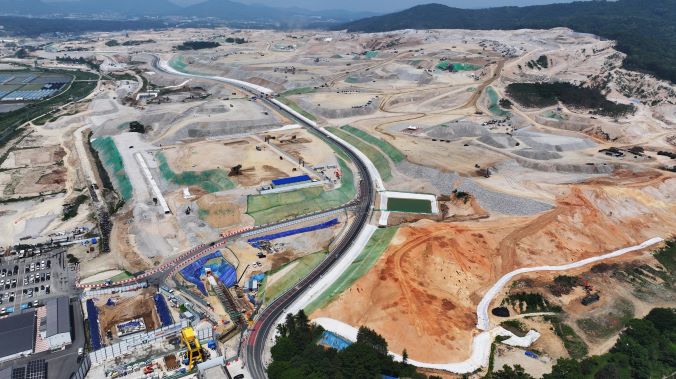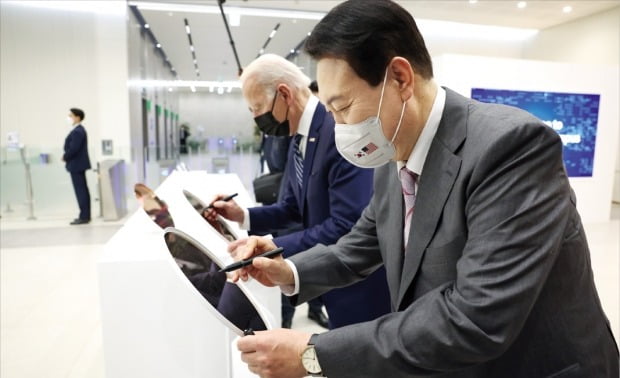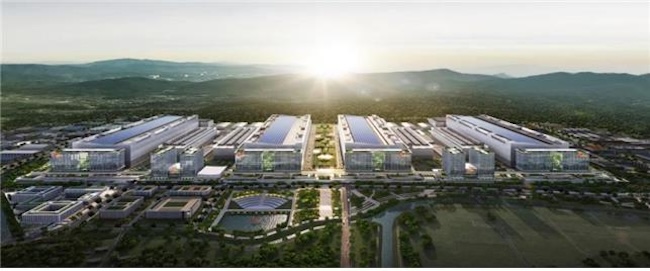
The South Korean government has pledged to accelerate the construction of a “semiconductor mega-cluster” in southern Gyeonggi Province. This photo, taken on the afternoon of May 23, shows the site of the Yongin Semiconductor Cluster in Yongin, Gyeonggi Province, coinciding with the government’s announcement of new measures to support the semiconductor industry. (Image courtesy of Yonhap)
SEOUL, May 25 (Korea Bizwire) – The United States, China and countries around the world are waging an intense battle to gain supremacy in the semiconductor industry, crucial for cutting-edge technologies.
On May 23, in a meeting presided over by President Yoon Suk Yeol, South Korea’s government unveiled a comprehensive 26 trillion won support package for the semiconductor industry, including a 17 trillion won financial aid program for chipmakers through state-run banks.
This comes as the United States lures global companies with astronomical subsidies under its chip law, while nations deploy an array of tools — subsidies, tariffs and trade barriers — to bolster their semiconductor industries.
The South Korean plan extends tax credits set to expire this year and establishes a 1 trillion won fund to nurture the chip ecosystem, including fabless firms that design semiconductors. It also aims to accelerate infrastructure development for a semiconductor “mega cluster” under construction in southern Gyeonggi Province.
The package significantly expands on an earlier 10 trillion won aid program announced after a meeting with chip exporters on May 10. “Semiconductors are a field where an all-out national struggle is unfolding,” President Yoon said, adding, “Countries around the world are staking their fate on semiconductors.”

During his 2022 visit to South Korea, U.S. President Joe Biden toured Samsung Electronics’ semiconductor facility in Pyeongtaek, Gyeonggi Province. In a symbolic gesture, President Biden and South Korean President Yoon Suk Yeol signed a semiconductor wafer, rather than a traditional guest book. This wafer is slated for use in Samsung’s pioneering 3nm process, which the company aims to be the first to mass produce globally. (Image source: Presidential Office of the Press Secretary)
Major chipmakers like Samsung Electronics and SK Hynix plan astronomical investments to brace for intensifying global competition, including 622 trillion won through 2047 to establish the mega cluster. Bloomberg News described the announcement as the government taking a more active role after favoring company-led investments.
The United States is attempting to reshape supply chains from a security perspective through measures like the Chips Act. It plans to offer $39 billion in subsidies for new factories, along with $75 billion in loans and loan guarantees plus a 25% investment tax credit. Companies including Samsung, Intel, TSMC and Micron have already been awarded $32.8 billion in subsidies.
Washington has rolled out export controls to restrict shipments of advanced chips and chipmaking equipment to China. It recently announced plans to raise tariffs on Chinese semiconductors from 25% to 50% next year.
The European Union enacted its own Chips Act last year, aiming to double Europe’s share of global chip production to 20% by 2030, with total investment reaching €43 billion including private funds. Bloomberg estimates the U.S., EU, India and Japan have committed close to $80.7 billion in semiconductor subsidies.
Neighboring countries are also going all-in on the semiconductor race. Taiwan, home to the world’s largest foundry, TSMC, is pouring efforts into nurturing the industry as a national priority. The new president has dubbed an ambitious plan to make Taiwan an “AI island” by leveraging its semiconductor prowess.

This image provided by the Ministry of Trade, Investment and Energy shows the concept of SK hynix Inc.’s semiconductor cluster under construction in Yongin, 33 kilometers south of Seoul. (Image courtesy of Yonhap)
Though opaque, China’s semiconductor subsidies are estimated to vastly outpace the U.S. The Semiconductor Industry Association pegs Beijing’s spending at over $142 billion, with a further $27 billion fund to invest in domestic champions.
Japan, having mapped out semiconductor plans in 2021, has secured $25.3 billion in funding. It plans to offer up to $10.5 billion for TSMC’s plants in Kumamoto and $8.1 billion for an industry consortium including Toyota and NTT. Tokyo aims to triple domestic chip sales to $96.3 billion by 2030 through $64.2 billion in total private and public investment.
Kevin Lee (kevinlee@koreabizwire.com)



